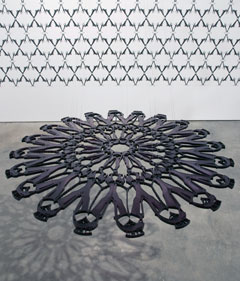ProtoCAM’s rapid prototyping techniques and technology are ideal for the creation of 3D art from CAD drawings.
 Background
Background
Kiki Seror is an artist living and working in New York City. She was preparing a number of pieces for a solo exhibition at the I-20 Gallery in Chelsea when she contacted ProtoCAM.
Seror had 3D CAD drawings of the objects created using NewTek Lighwave software on an Intel Mac. While this software is not commonly used by ProtoCAM customers – typically product development engineers – Seror was able to produce STL files that could be used to make the pieces.
Challenge
Seror needed ProtoCAM to produce the 3D art pieces in the clearest, most transparent material possible for lighting from below. But after ProtoCAM’s engineers reviewed the 3D drawings, they were somewhat concerned about the thinness of some areas shown in the drawings – and the fragility that would result.
Solution
ProtoCAM’s rapid prototyping engineers worked closely with Seror to make a few small adjustments to the drawings to increase the wall thickness while maintaining the integrity of the art. ProtoCAM was able to then produce the 3D art objects using stereolithography (SLA)and the most advanced, clearest SLA materials available.
Initially there were two different designs which were produced in editions of five. The pieces were displayed on elevated lightboxes, producing a striking visual effect.
Results
After successfully completing these pieces, Seror returned to ProtoCAM to inquire about creating two additional works that were more challenging. The goal was to create two large circular objects (about 4 feet in diameter) with repeating patterns that she had created. These two round works would be suspended to be exhibited. The challenges included:
- Ensuring the individual objects could be produced with appropriate thicknesses to support the fine detail
- Joining the individual elements to create the large circular designs
- Making sure the individual pieces would be constructed so that they could be transported and then suspended from the ceiling in the gallery
- Having a surface / finish that would accept coloring
- Meeting the time constraints to have the art ready for the opening of the exhibition
ProtoCAM was able to collaborate with Ms. Seror to work out all of these issues and complete the job in time for the installation and opening.
Many thanks to Kiki Seror and I-20 Gallery for working with ProtoCAM on this project and for allowing ProtoCAM to provide this case study.
